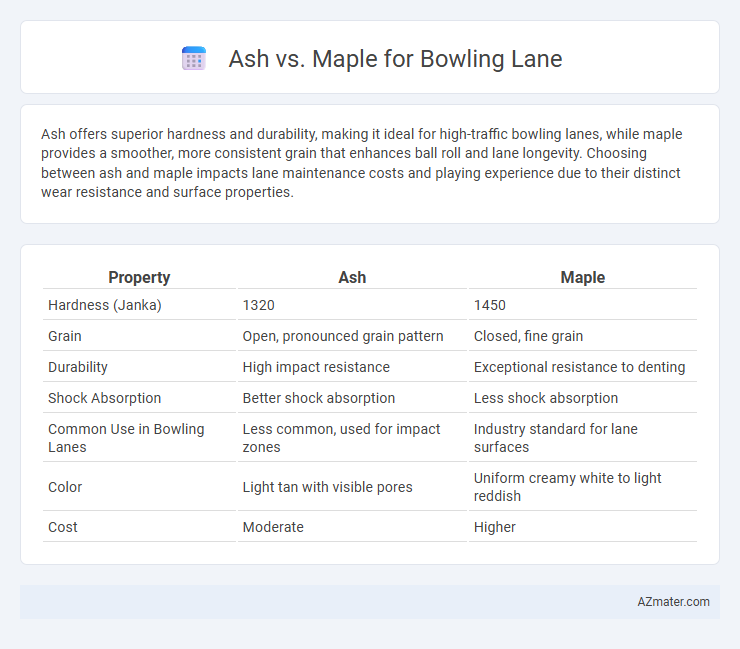Ash offers superior hardness and durability, making it ideal for high-traffic bowling lanes, while maple provides a smoother, more consistent grain that enhances ball roll and lane longevity. Choosing between ash and maple impacts lane maintenance costs and playing experience due to their distinct wear resistance and surface properties.
Table of Comparison
| Property | Ash | Maple |
|---|---|---|
| Hardness (Janka) | 1320 | 1450 |
| Grain | Open, pronounced grain pattern | Closed, fine grain |
| Durability | High impact resistance | Exceptional resistance to denting |
| Shock Absorption | Better shock absorption | Less shock absorption |
| Common Use in Bowling Lanes | Less common, used for impact zones | Industry standard for lane surfaces |
| Color | Light tan with visible pores | Uniform creamy white to light reddish |
| Cost | Moderate | Higher |
Introduction to Bowling Lane Materials
Bowling lanes are primarily constructed from hard, durable woods like ash and maple due to their strength and resilience under constant impact and friction. Maple offers superior hardness and a smoother surface, making it ideal for the strike-zone where precision and consistency matter most. Ash, while slightly softer, provides excellent shock absorption and flexibility, often used in the approach area to balance performance and durability.
Overview of Ash Wood in Bowling Lanes
Ash wood is highly valued in bowling lane construction due to its exceptional hardness and shock resistance, which enhances durability under repetitive ball impact. The straight grain and uniform texture of ash provide a smooth, consistent surface that maintains lane integrity and reduces maintenance frequency. Its high elasticity and strength contribute to consistent ball performance and longevity of the lane structure.
Overview of Maple Wood in Bowling Lanes
Maple wood is the preferred material for bowling lanes due to its exceptional hardness, durability, and consistent grain structure, which provides a smooth and reliable playing surface. Its tightly woven fibers resist denting and wear from repeated impacts of bowling balls, maintaining lane integrity over time. The natural resistance of maple to moisture and warping ensures long-lasting performance and minimal maintenance in bowling alleys.
Physical Properties: Ash vs Maple
Ash and maple are the primary hardwoods used for bowling lanes, each offering distinct physical properties that impact lane performance and durability. Ash features a more open grain structure, providing greater elasticity and shock absorption, which helps reduce ball deflection and enhances pin action. Maple is denser and harder, delivering a smoother, more uniform surface with superior resistance to impact and abrasion, making it ideal for the high-wear area in front of the pins.
Durability and Longevity Comparison
Ash bowling lanes offer superior durability due to their dense grain structure, which resists denting and wear over time. Maple, while slightly less dense, provides excellent longevity with consistent performance thanks to its tight, uniform grain that withstands heavy ball impact and friction. Both woods are premium choices for bowling lanes, but ash generally excels in toughness, whereas maple is preferred for a smoother, more resilient playing surface.
Impact on Bowling Ball Performance
Ash bowling lanes offer a harder, more durable surface that provides higher ball speed and consistent pin action, enhancing overall ball performance. Maple lanes have a slightly softer grain, which allows for better ball control and more pronounced hooking potential due to increased friction. The choice between ash and maple significantly influences ball reaction, with ash favoring power and maple promoting precision.
Maintenance Requirements: Ash vs Maple
Ash bowling lanes require more frequent maintenance due to their lower hardness and susceptibility to denting and wear compared to maple. Maple lanes, known for their superior hardness and durability, offer longer-lasting surfaces that resist ball marks and require less frequent refinishing. Choosing maple reduces overall upkeep costs and extends the lane's service life in high-traffic bowling environments.
Cost Differences and Budget Considerations
Ash wood offers a more affordable solution for bowling lane construction compared to maple, typically costing 10-20% less per board foot. Maple, known for its durability and superior shock resistance, commands a higher price but may reduce long-term maintenance costs and increase lane longevity. Budget allocation should weigh initial material expenses against potential savings in repairs and lane replacement frequency.
Environmental Impact and Sustainability
Ash and maple are the two primary hardwoods used for bowling lanes, each with distinct environmental impacts and sustainability profiles. Ash is generally more renewable due to faster growth rates and widespread availability in North America, which supports sustainable forestry practices and reduces deforestation pressure. Maple, prized for its hardness and durability, often requires more intensive harvesting, but certification programs like FSC (Forest Stewardship Council) promote responsible sourcing to minimize environmental harm.
Choosing the Right Wood for Bowling Lanes
Ash wood offers excellent shock absorption and durability, making it a popular choice for bowling lanes due to its ability to withstand heavy impacts and resist wear. Maple is prized for its dense, hard surface that provides a consistent, smooth ball roll and superior resilience against scuffing and dents. Selecting the right wood involves balancing ash's flexibility and maple's hardness based on lane usage, maintenance capacity, and desired playing characteristics.

Infographic: Ash vs Maple for Bowling Lane
 azmater.com
azmater.com